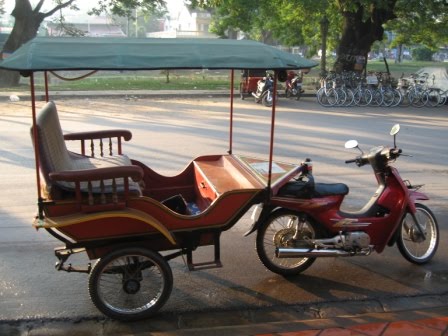Here are some things that we’ve noticed about Camdodia:
- Cambodia is officially a democracy, but the Cambodian People’s Party seems to control the place. They have signs up in every village and then win every election.
- Much of the country is flat. It is covered with rice patties as far as you can see.
- The food is very good. Our favourites are ‘amok’ – fish cooked with coconut milk and lemon grass in a banana leaf, and especially ‘lop lak’ – beef with lemon pepper sauce.
- Cambodian food is generally not spicy, unlike its neighbouring countries, but you can add chili sauce or raw chilies at the table.
- People eat using a spoon with the fork only to help maneuver food onto the spoon. Chopsticks aren’t common.
- The Cambodian currency is the ‘riel’, with about 3500r to the Canadian dollar. US dollars are also widely used here. Many tourist attraction and hotel prices are quoted in US dollars but they will accept either currency. Change less than one dollar US is given in riel.
- Tuk-tuks in Cambodia, rather than being an integrated 3-whelled vehicle, are a 2-wheeled cart pulled by a 100 cc motor scooter with driver. They are very comfortable (lots of leg room) and have better views than the tuk-tuks we’ve experienced anywhere else.
- Some Cambodians appear resentful of their more prosperous neighbours Thailand and Vietnam. This may be rooted in history, as these regions have been fighting for thousands of years.
- The official state religion of Cambodia is Buddhism, but for much of its history it was Hindu or Brahmist. The famous Angkor Wat temple is a Hindu temple.
- Cambodia was a French colony from 1884 to the 1950’s. At that time the Cambodian King left the country and refused to return until the French left, which they did due to international pressure.
- From 1974 to 1979 Cambodia was the site of a terrible genocide orchestrated by a group called the Khmer Rouge. During this period the country was called ‘Kampuchea’, and it widely recognized by foreign governments despite the atrocities committed here.
- Anti-personnel mines (land mines) and UXO (UneXploded Ordinance, like bombs, mortar shells, grenades, etc.) are still common in Cambodia. There are estimated to be between 3 and 6 million land mines left in the country, most of which are unmarked. Many civilians are injured each year by land mines. Tourists are advised to stick to roads and marked trails only.
